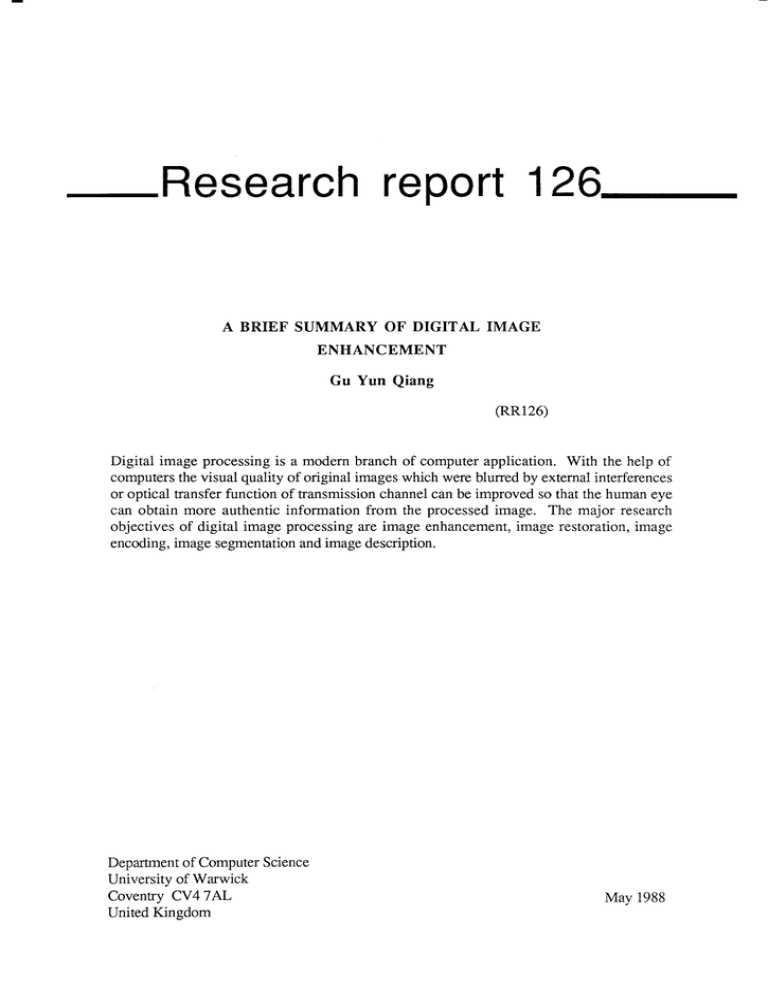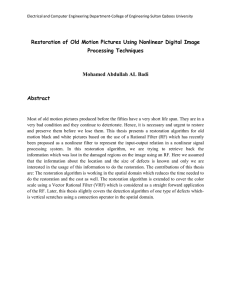-Research report 126 DIGITAL
advertisement

report 126
-Research
A BRIEF SUMMARY OF DIGITAL IMAGE
ENHANCEMENT
Gu Yun Qiang
(RR126)
Digital image processing is a modern branch of computer application. With the help of
computers the visual quality of original images which were blurred by external interferences
or optical transfer function of transmission channel can be improved so that the human eye
can obtain more authentic information from the processed image. The major research
objectives of digital image processing are image enhancement, image restoration, image
encoding, image segmentation and image description.
Department of Computer Science
University of Warwick
Coventry CY47 AL
United Kingdom
May
1988
A Brief Summary of Digital Image Enhancement
GuYun Qiang
Department of comPuter science
University of Warwick
CoventrY
CY47NABSTRACT
Digital image processing is a modem branch of computer application.With
the help of computers the visual quality of original images which were blurred by
extemal interferences or optical transfer function of transmission channel can be
improved so that the human eye can obtain more authentic information from the
processed image.The major research objectives of digital image processing are
image enhancement,image restoration, image encoding,image segmentation and
image description.
Image Enhancement
The principal objective of image enhancement is to strengthen some information of the original
no
image for a specific application.Because of the variety of the different sorts of images there is
general theory and approach for enhancing pictures.A image which has such low contrast that it is
barely visible,for example,by using histogram modification techniques its contrast can be
improved.The results of applying a lowpass filter is image smoothing. Image sharpening can be
achieved in the frequency domain by a highpass filtering process.
Histogram Modification Techniques
A histogram is a statistical figure which shows the graylevel distribution of the pixels in
a
image.A narrow range of graylevel values occupied by the pixels of a original image indicates
that the pixels in the original image have little dynamic range and the contrast of this picture is
very low. Naturally,we want to spread the histogram throughout the fuIl range of graylevels to
funcenhance the contrast of the image.In other words,it is expected that the probability density
tion of the transformed graylevels is a constant in the interval of definition.
Consider the transformation function
S=I(r)
=f,'n,@)dw
May 8, 1988
0<r
<I
where p, (r ) is graylevel probability density function
p,\r)= ds,
.
dr
It
follows from elementary probability theory that the probability density function of
the
transformed gray levels is given by the relation
I
I
| .,a,1 =lp,(r)
t ' ..
A(s)=ln,U)j;l
' ' n,t''l
^l=r
1 -"'J ,=r'1"y l'
1
03s<1
ln the discrete case,the graylevel transformation function is
st =r(rt) =
i+
=
ja"
0 Srp
& =0,1,
!p,e)
j4
3l
"'L-I
Related probability density functionp"(se) can be yielded by dividing the number of the pixels
which were mapped to the same .rr by the total number of pixels in the image.That is,
ll2
?"\s* ) =
0(4Sl
,t=0,1,"'L-I
It is sometimes descriable to be able to specify interactively particular histograms
highlighting certain graylevel ranges in
(1)
a image.The procedure can be summarized as
Equalize the levels of the original image using Eg.
k lt;
k
sk=T(rk)=>--L=lp,?1)
rt
j4
0<16 <
k
j=o
1
=0,1,'..L-|
May 8, 1988
capable
follows:
of
5
(Z)
Specify the desired density function p,
(z
) obtain
the transformation function g (z) using Eg.
k
vk=
(3)
gQ)= DP"Qi)
j4
Apply the inverse transformation function Z = G-r(s) to the levels obtained in step (1).
Image Smoothing
Smoothing operations are used primarily for diminishing spurious effects that may be present by
noise.
lll
Neighbourhoodaveraging
Heighbourhood averaging is a straightforward spatial-technique
smoothed image is obtained by using the relation
s @ ,v)
11
= M>f
@
,m) +
for image
smoothing.The
VZn@ 'm)
The variance of the noise is
,",1#>ra,^l= #o
It is obvious that after smoothing operation the variance of the noise is down to l/M of the original variance
d
. For a given radius, the smoothed image is obtained by using the relation
where T is a specified nonnegative threshold.
tZl
Median filtering
Median filter technique is a straightforward smoothing approach.When the template
F1
lx*xl
l;;;l
May 8, 1988
4
covers the nine elements the central element is substituted by median which is the median of the
sequence of the nine elements ordered by magnitude.
t3l
Lowpass filtering
Sharp transitions ( such as noise and edges ) in the gray levels of an image contribute heavily to
the high-frequency content of its Fourier transform.The function of lowpass filtering approaches
is to filter out a specified range of high-frequency components in the transform of a given image
and to let the information in the low-frequency range pass without attenuation.
The transfer function of ideal lowpass filter is
H(u,v)=l
It ifD(u,v)<Ds
o ira@,v)>Ds
where D0 is the cut-off frequency locus,D(u,v) is the distance from point (u,v) to the origin of the
frequency plane.
For avoiding "ringing" phenomenon and passing a fairly high amount of high-frequency information to preserve more of the edge content in the picture following several filters were improved.
Butterworth Iilter
II (u -v\
I + (rf2_l) ID (u,v)tDo]2"
Exponential filter
. - fL"tvi-zl'l
rLlo<"."t,o1'
t
H(u,v):s
Trapezoidal lilter
1
lD (u,v)-D r)
"t,"r={
IDo-Df
0
ifD(u,v)<Ds
tfDo<D(u,v)<D,
rfD(u,v)>D1
whereDs and Dt are specified,and it is assumed thatD0 < Dr.
May 8, 1988
Image sharpening
The following sharpening techniques arc usefrrl as the enhancement tools for higtrlighting edges
in an image which was blurred after transmission or transform.
t1l
Sharpening by differentiation
In the one-dimensional case, the sharpened wave shape is shown below
idealwave
f
(x)
*f
4_
dx
drL
j@!.
dJcz
s@)=f
(D-+
ca-
\"r'
Similar expression holds for two dimensions using Laplacian
s@,y)=f(x,y)-aYz(xX)
where a is specified.
The discrete form of above expression is given by the relation
s (x ,y) =
f
(x
fl-tf
@+1$+f
(x x
+\+f
(x
t -D+f @-r s)af @ s ))
This Eq. can be expressed by the template
o -a ol
0 -a 0l
-a l+4a-a
I
By properly selecting a threshold, it is possible to emphasize signiflcant edges without destroying
the characteristics of smooth backgrounds
l2l
Highpass filtering
change which includs a large amount of high-frequency
components,image sharpening can be achieved in the frequency domain by a highpass filtering
process which attenuates the low-frequency components without disturbing high-frequency infor-
Since edge
is a abrupt graylevel
mation.
May 8, 1988
Ideal highpass filter
Its transfer function can be defined by the relation
(g ifD(u,v)<Ds
H(u,v)/1 ifo (u,v)>Do
with cut-of frequency locus at a distance Do from the origin.
Butterworth fi1ter
/
ratu.yt=' ' \q,'
I
1
+
tfz_tl
ID otD (u ,v)]2"
Exponential fllter
H (u ,v) =
,-
lnu{zl
lD JD (u 'v))"
Trapezoidal fllter
ifD(u,v)<D,
lf D r< D (u,v) <D
ifD(u,v)>Ds
Homomorphic filtering aPProach
An image, f(xl),can be
expressed
in terms of its illumination,i(xJ),
reflectance,r (.r,y ),components by means of the relation
f
Let
z
(x,y) =
ln
f
(x,Y) = i(x
t)r
(x,Y)
(x,Y) = ln i (x J) + ln r(x,Y )
then,
Z(u,v):I(u,v)+R(u,v)
let
S
(z ,v ) = H (u,v)I (u ,v) + H (u ,v)R (u ,v)
May 8, 1988
and
then
s(r,y) = o-{rt,",} = ro,y) + r' (x,y)
where
i' (x ,y)
i
=
(x ,y) =
n-{:a
o-Io
<u
,uU
tt
,r," r* ,
,"
+
,)
The desired enhanced image is
j'
s (x'y ) = exp r (r J ) = exp (x J
)
exp r' (x g ) = i o@
J ) r o@'y )
The illumination component which is characterizedby slow spatial variations is associated with
the low frequencies of the Fourier transform of the logarithm of an image and the reflective component which tends to vary abruptly with the high frequencies;therefore, the specified filter function , H(u,v),will tend to decrease the low-frequencice and amplify the high- frequencies'In fact,it
is a highpass filter.
Pseudo-color and false'color processing
The human eye can discem thousands of color shades and intensities.This is in sharp contrast
with the eye's poor performance with gray levels. The objective of pseudo-color technique is to
assign a color to each pixel of a monochrome picture based on its gray level.
t1l
Density slicing
Suppose ttrat
M planes partition the gray scale into M+l regions and color assignments are made
according to the relation
f(x,Y):c* if/(xY)i;Ro
where Cu is the color associated with the kth region, Rp
.
A altemative representation is shown below
il
,,,
r*
*"
q-**t
!,
May 8,
1988 i s-r i ;
r,i
i
12)
Gray-level-to-color transfolnations
This approach is to perform tfuee independent transforms on the gray levels of any input
pixel.The tfuee elements of the results are shown below
In(x,Y) =Tnf @,Y)
Ie@'Y)=Tef@'Y)
Is@,Y)=Trf@,Y)
where Tp , T6 and
T,
are three spesified transformation functions,respectively.
Then the three color elements overlap in TV monitor and produce a composite image whose color
content is modulated by the nature of the transformation function.
t3l
Filtering approach
The objective of this color processing technique which is shown in following figure is to colorcode regions of an image based on frequency content.
l4l
False color processing
This method is based on a special case that the original image is a color picture.The procedure of
the false color processing can be described by means of a simple example.Consider the relation
[o,l
[o o rl [n']
lG^l=l100llG'l
Lr,l lo t ol irii
May 8, 1988
9
where
Rf , Gf and.By
are the three color elements
color elements of the false color image
of the original image"R, , G, and B, are the
.
In fact. this is a sort of color coordinate transforms from the original three primary colors to
a
new set of three primary colors.
Image Restoration
The expression describing a linear degradation model of an input image,
/
(x,y),is
cc- -.
s(x,y) =JL,f (d,B) h(x,as,il dud\ +rl(x,y)
If H is position invariant, this expression
becomes
tt*
- JL/^,(d,p) h (x -ut
-9)
d
adB + n(x,v )
,y): I > f "(m ,n) h"(x-m
m=On4
S
-n ) + q, (r
s @,y)
The discrete degradation model is
M-lN-r
g"(x
,y
)
It can be expressed in the following vector-matrix form
g=H
where
f
+n
vectors formed by stacking the rows of the
(x,y ), e"(x ,y) and q, (x,y ), the matrix H is a block-circulant matrix.
f ,g nd z represent MN-dimension column
M xN functions
/,
Unconstrained restoration
Wewishtofindaf suchthat lln l12= llg
-tlitt2
isminimum.
Let
dil ts - uf tlzl
=ff
=-u-l'(g -Hf )=0
oI
Wehave
i
=1H'H\-|H'g
If H is a square matrix,then
i
= tt-'(n')-1H'g
= H-r g
May 8, 1988
10
Constrained restoration
This is
problem.We seek anf which minimizes the criterion function
a least-squares restoration
tG)= ttgi tt2+c(l
where
lg -
ni tt2- ttnttz)
a is a
u(llg -Hf
constant called the Lagrange multiplier,o
hatl12+ llz lt2listheconstraint.
is a
linear operator on
,f '
Let
Ag
=o=
dJ
2e,ei -
zaH, (e
- Hi
)
then
i
.l
wnere
y
=1n'n+yg'Q)-rH'g
- -.0
Inverse filtering
Based on the discussion that the discrete degradation model is
M-TN_I
g"(x,y)=
t
> f
mAn4 "(m,n)h"(x-mJ-n)+t1"(x,y)
we have that the following frequency-domain relation holds
G
(u,v) = H (u,v)F (u'u) +N(a'v)
where G ,F andN are the Fourier transforms of the degraded image, original image , and noise, H
is a "filter" function.
Let
F(u'v)=m
Considering noise term this equation can be expressed in the following form
F @,v) = F (u
,v).
ffi
May 8, 1988
11
The restored image is obtained by using the relation
f (x,y)= r-'[r1u,rl
LJ
dominate the
restoration result.In order to avoid small values of H(u,v), in practice,we carry out the restoration
in a limited neighborhood about the origin.
It is important to note that if H(u,v) is zero or becomes very small the term could
Removal of blur caused by uniform linear motion
Suppose that the imge in question undergoes uniform linear motion in the positive x-direction
only and y is time invariant.The total exposure at any point can be expressed in this form
,\
s(x)=l"T,f tr-ro1rlldt =L-f 6)dx
x=x-atlT .0<X<L
then,by differentiation,
g'(r)
=
f
(x) -
f (x-a) .
ItwillbeCOnvenienttOassumethatL=Ka,then,x=z+mQ,Where0<zca,t\t=0,1,2,"",K-1
m is the integral pafiof
Then, we
have
L
.
f
(z+ma) = g' (z+ma) + f
lz+(m-l)al
'
Let
QG):
It is evident
rhat
f
f
(z-a)
(z+ma) can be expressed in the form
f
(z+ma) =
i
t={
g' Q +ka) + 0(z)
or
$@-ma)=f(x)-is'@-ko)
k4
then.
K-l
KQ(r) =
K-l
m
E t g' (x+ka-ja)
| f (x+kt) - k=oi=0
,t=0
May 8, 1988
,
t2
Let
K-1
Z f @+kt)=xn
t=0
Q@-ma) = A
1K-lm
- ;,' r{j=o
I I s' (x+(k-m)a-ja)
The final result becomes
f
(x) = A
m
1K-lm
- r\oDZ
t{i=o
g'
@-*a+(k-i)a) +
2
8'
@-ja)
i=0
Least-squares(Wiener) fi lter
Consider the least-squares restoration problem, we seek
anf which minimizes
tion and the solution is
i
= (H,H +
\e,e)tH
g.
By defining Q'Q = RlrR,
where
-, =
o.
=
4uI
t{*}
=wAW-l
=wBW-,
We yield
i : 1wo' nw-| + ywA-tBW-\-twD* w-t I
or
w-ri =(D. D +yA-rByrp*ry-t,
The elements
of
this equation can be written in the form
.-l
Ftu.v)=l
I H (u,v )
|
H
(r,r)
-ta@'v)rz
yls
l\
"(r,r)W
May 8, 1988
I ^'\u'v )
)u
the criterion func-
13
Constrained least-squares restoration
The constrained least-squares restoration procedure can be summarized as follows'
Step
1
Choose an
initial value of l and obtain an estimate of I lz I 12 using
I tn I t2 =(M-1XN-1)to'fr + ql1
Step 2
Compute F(rz,v) using
H*(u,v)
A, , t
Ffu.v\=l-1tt(u,v)
|
|
H
(u,v)l'
'l
+ YIP (u,v)1" )
^
OUtainf by taking the inverse Fourier transform of F (u,v).
Step 3
Form the residual vector r according to r = g
-
Hi
mdcompute 0(y) = | lyl
12
.
Step 4
If 0(y) < | ln I 12- a, increment Y.
If 0(9 > llnl12+a,decrementY.
Step 5
Retum to step 2 and continue unless
Q(y)
= | lnl12+ a.
Interactive restoration
The Fourier transform of a two-dimensional coherent sinusoidal noise is given by the relation
N(z,v) =
#lUr-ud2n
,v-vst2n) - 6(u+us/2x ,v+uat2n)f
May 8, 1988
t4
By using a bandreject filter the pair of impulses in the frequency plane can be cleaned up'The
transfer function of the bandreject lilter is
H (u
[O tfDl@,v)<Do or
'v)lt I otherwise
D2(u,v)<Do
where
D 1(u,v)= f(u-us)2 +
(r-vd'ft'z
D 2@ ,v) = 1(u+u)2 + (v +v s)z)rtz
It is a common problem that the interference pattem is composed of more than just one sinusoidal
component.In this case,the restored image can be expressed in this form
i
g (x
@,y) =
J) -
w (x,y)P (x
l)
where e@,y) is the comrpted image, p(x,y) is the interference pattem, w(x,y) is a weighting
function to be determined.Then,
&G,fi-l
lxY^
Let
doz(x
J)
dw(xil
=n
The result is
e@t)P@t)- e@t)P@t)
..,,-,,\
,vtL-v
t- -
p'\xJ)-p
\x,v)
Conclusions
The above represents a brief summary of the large range of techniques for improving the quatity
of images , eilher to enhance their visual quality or to satisfy some objective criterion , such as
m.s.e. Further details may be found in the references below .
References
tll
R.C. Gonzalez
&P. Wintz , 'Digital Image Processing,'
May 8, 1988
Reading , Addison-Wesley ,1977.
15
H.E. Knutsson , R. Wilson, and G.H. Granlund , "Anisotropic Nonstationary Image Estimation and lts Applications: Part l--Restoration of Noisy Images," IEEE Transactions on Communi-
l2l
cations , March 1983.
t3l
H.C.Andrews
r976.
,
"Monochrome Digital Image Enhancement," Applied Optics , February
N.C. Gallagher , Jr. and G.L. Wise , "A Theoretical Analysis of the Properties of Median
Filter," IEEE Transactions Acoustics , Speech , and Signal Processing , December 1981.
l4l
I5l
M.P. Ekstrom , "Realizable Wiener Filtering in Two Dimensions," IEEE Transactions on
Acoustics , Speech , and Signal Processing , February 1982'
t6l
A.A. Sawchuk , "Space-Variant Image Motion Degradation and Restoration," Proceedings of
the IEEE , July 7972.
D.T. Kuan , A.A. Sawchuk, T.C. Strand , and P. Chavel , "Adaptive Noise Smoothing Filter
for Images with Signal-Dependent Noise," IEEE Transactions on Pattem Analysis and Machine
Intelligence , March 1985.
l7l
t3l
R. Chellappa and R.L. Kashyap , "Digital Image Restoration Using Spatial Interaction
Models," IEEE Transactions on Acoustics , Speech , and Signal Processing , June 1982.
May 8, 1988





